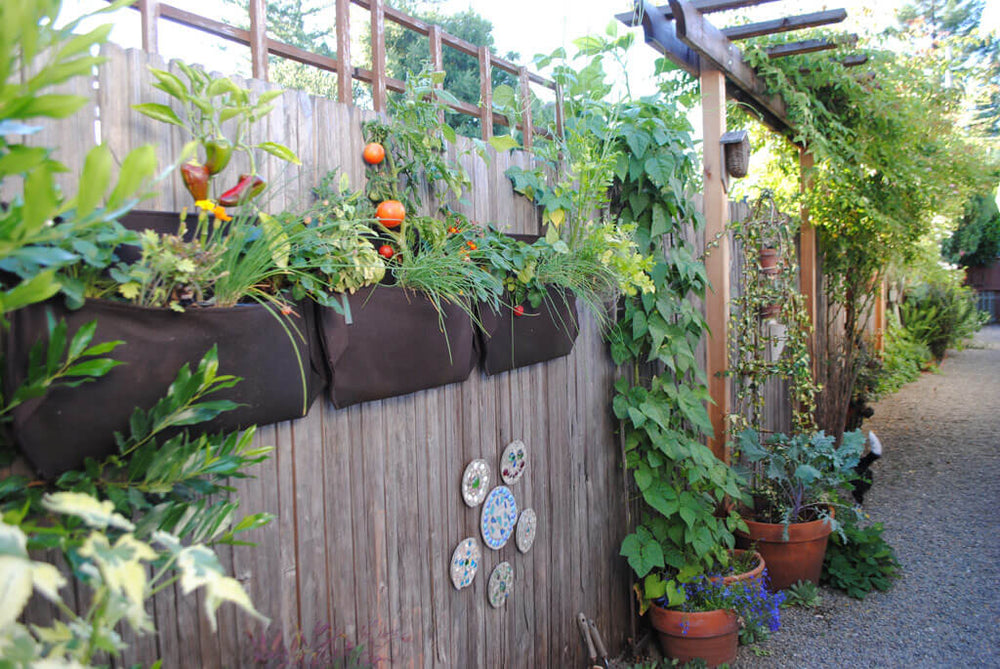Although vertical gardening has been a trend in recent years, it's becoming a permanent shift in how we think about gardening. Using vertical planes obviously makes sense for those who have limited horizontal space — apartment dwellers and condo owners, for example. But even those who have large properties can benefit from new and creative ideas for taking their gardens to lofty heights. Because many people think of vegetables and herbs as belonging in perfectly straight garden rows, it can be difficult to envision more creative approaches to planting them. Here are some fresh vertical gardening ideas to consider trying for yourself.
Build a trellis
Using sturdy materials like 2 x 4's and hardware cloth, you can fashion trellises for all of your climbing and vining edibles. Not only will doing this make the plants easier to harvest, but it also allows more room in the ground for vegetables and herbs that tend to bush or clump. Small pumpkins, summer squash, cucumbers, peas, and green beans will love scrambling up the trellis, and they'll be easier to maintain and harvest when their long vines are elevated.

Go industrial
If you spend any time online, you'll see planters made from items like cinderblocks, wooden pallets, and rain gutters. Available at home improvement stores, these make very unusual and creative vertical planters. One caveat: When planting edibles, use only new, clean cinderblocks lined with plastic (punch drainage holes into bottom), and wooden pallets that have not been chemically treated.

Hang a basket
Dangle smaller containers like these anywhere you want a vertical splash of interest. Combine lettuces and herbswith colorful annual flowers for a planting that's both edible and bold.

Plant a hayrack
Anyone who has a balcony, deck, or porch railing can try vertical gardening. Just hang a hayrack planter, line it with cocoa fiber or moss, and have a little herb garden at the ready. Smaller herbs like thyme, chives, mint, and parsley are a great choice—and don't forget to add some annuals if desired.

Invest in a "living wall planter"
These self-watering pockets allow you to grow on virtually any vertical surface. Most are fabricated from plastic, wood, or a heavy-duty felt, and are perfect for herbs, small- to medium-sized vegetable plants, and smaller fruit bushes (such as berries).

Reuse a rack
Got an old utility or shoe rack lying around? Line the shelves with moss and plant herbs and vegetables to your heart's content! Either lean the rack against an outside wall, or mount it. Watering tip: Moss drains very quickly, and many gardeners can get frustrated trying to keep their plants properly hydrated. To avoid this, add a layer of plastic with drainage holes below the moss.

Shop the feed store
Animal feed is often sold in very large, colorful plastic bags* that could almost double as works of art. Make a unique vertical planter by poking drainage holes in the bottom, cutting handles into the top for hanging, then adding potting soil and plants. It's recycling at its best! (* If plastic begins to flake off over time, replace or keep away from water sources.)

Plant upside down
You've seen those tomato planters on TV that grow tomatoes upside down, but for a few dollars you can get into vertical gardening by making your own. Start with a new, clean 5-gallon bucket and, using a utility knife, cut a circle out of the bottom that's just large enough to feed a small determinate tomato plant through. Add a few smaller holes for drainage, then fill the bucket with potting soil and hang it wherever there's sun.
Photo courtesy of Chris McLaughlin.Jenny Peterson is a landscape and garden designer living in Austin, Texas. At her website, JPetersonGardenDesign.com, you'll find lots more design tips and DIY projects. Jenny is also an urban farmer and vegetable gardener, and is co-author of Indoor Plant Décor: The Design Stylebook for Houseplants.





 Herbs
Herbs
 Vegetables
Vegetables
 Fruit
Fruit
 Flowers
Flowers
 Succulents
Succulents


